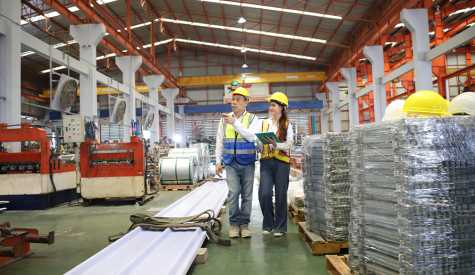Prevent Workplace Injuries: A Guide to Machine Guarding

Imagine working beside a machine, the hum of its parts a constant backdrop to your day. Now, imagine that same machine poses a silent threat—one that could change your life in an instant through injury. This isn't just a hypothetical scenario for thousands of workers each year; it's a reality.
Machine-related injuries such as amputations, lacerations, and crushings are not only possible but prevalent in the absence of proper safety measures. This guide is your solution to understanding and implementing effective machine guarding strategies, ensuring workplace safety, and compliance with the Occupational Safety and Health Administration (OSHA) standards.
The Importance of Machine Guarding
Without adequate machine guarding, workers are exposed to numerous hazards. Real-life incidents have shown that injuries from unguarded machinery can be severe, leading to amputations, deep lacerations, or even more tragic outcomes. For instance, consider a scenario where a worker's hand is caught in an unguarded press machine, resulting in serious injury. These are not isolated incidents but a compelling call to action for implementing rigorous safety measures.
OSHA mandates machine guarding as a fundamental safety requirement designed to protect workers from the inherent dangers of operating machinery. Non-compliance risks worker safety and subjects businesses to potential fines and legal liabilities. Adhering to these standards is not merely a legal obligation but a moral one, prioritizing the wellbeing of every employee.
While compliance with OSHA standards is a primary motivator, the advantages of machine guarding extend far beyond. Implementing robust guarding systems can significantly enhance a workplace's safety culture, protect valuable human resources, and can even reduce operational costs by lowering insurance premiums through mitigated risks.
Types of Machine Guards and Their Applications
Transitioning from the why to the how, let's explore the types of machine guards that are available and their specific uses.
Fixed Guards
- Overview: Considered the most reliable form of protection, fixed guards are immovable barriers that physically block access to hazardous areas. These guards do not move with the machine parts and are often made of sturdy materials like metal or hardened plastics.
- Ideal Use Cases: Fixed guards are well-suited for machines with consistent operation patterns where access to moving parts is unnecessary. They are commonly found in equipment like belt drives, chain drives, and gear systems.
- Advantages: Fixed guards' primary advantages are their simplicity and reliability. Since they do not have moving parts, their likelihood of failure is minimal, making them a dependable choice for long-term safety solutions.
Adjustable and Self-Adjusting Guards
- Overview: These guards offer versatility, adjusting to accommodate various sizes of materials being processed. Their flexibility benefits machinery that handles multiple tasks, ensuring safety without sacrificing efficiency.
- Applications: Adjustable guards are commonly used in machines like wood planers and metal shears, where the size of the material being worked on can vary significantly. On the other hand, self-adjusting guards automatically adapt to the movement of the materials, making them ideal for use in operations like assembly lines.
- Key Benefits: The main benefit of adjustable and self-adjusting guards is their ability to provide adequate protection for different operational modes without manual adjustment, thereby reducing downtime and maintaining productivity.
Interlocking Guards
- Functionality: Interlocking guards are designed to halt machine operation automatically if the guard is removed or opened. This feature is crucial for automated processes, ensuring that machinery cannot operate without the proper safeguards.
- Typical Use: These guards are essential in heavy machinery and complex equipment that requires frequent access for maintenance or material changeovers, such as industrial presses or robotic assembly stations.
- Safety Enhancements: Integrating interlocking guards significantly enhances worker safety by preventing accidental startup during maintenance or when safety guards are not adequately secured, thereby mitigating the risk of injury.
Electronic Safety Devices
- Innovations in Safety: Modern advancements have introduced electronic devices like light curtains and laser scanners, which create an invisible barrier around dangerous parts. When breached, these barriers automatically stop the machine, offering a high-tech solution to machine guarding.
- Modern Applications: Electronic safety devices are increasingly used in environments requiring high levels of safety and flexibility, such as automated manufacturing lines, packaging plants, and robotic workstations. They are particularly effective in areas where physical guards could hinder operational efficiency or access needs vary rapidly.
- Advantages: The primary advantage of these electronic devices is their ability to provide immediate machine stoppage without physical contact, minimizing the risk of injury while allowing for easy access when it is safe. They also offer the flexibility to adjust protection zones quickly to fit changing production setups.
Each type of machine guard plays a vital role in protecting workers from the hazards of industrial environments. By understanding the specific applications and benefits of fixed, adjustable, interlocking, and electronic safety devices, safety professionals can make informed decisions about which types of guards are best suited for their operations, ultimately creating safer workplaces.
Strategies for Effective Machine Guarding
Machine guarding involves much more than simply knowing the types of guards available. The real challenge—and opportunity—lies in implementing these safeguards effectively to protect your workforce. Here's a closer look at approaching this critical task with the right strategy.
Step 1: Risk Assessment
The journey toward effective machine guarding begins with a thorough risk assessment. This proactive step is crucial in pinpointing which machines present danger and determining the most suitable type of guard for each situation. Doing so ensures that our safety measures are not just in place but tailored to address specific hazards, making them practical and appropriate for the challenges at hand.
Step 2: Guard Selection and Customization
Choosing the right guard is a nuanced process, requiring a careful evaluation of factors such as ease of use, durability, and the level of protection needed. However, the uniqueness of each machine means that off-the-shelf solutions might not always suffice. Customization becomes vital in these instances, allowing for guards that not only meet safety standards but also fit the specific operations of the machinery they are meant to protect, ensuring safety does not compromise efficiency.
Step 3: Installation and Maintenance
The effectiveness of a machine guard hinges greatly on its proper installation. This critical phase must be approached precisely, adhering closely to guidelines to ensure guards are installed and integrated seamlessly with their respective machinery. The journey doesn't end once the guard is in place—regular maintenance and inspections are paramount. This ongoing commitment ensures the guards maintain their integrity, providing continuous protection against hazards.
Step 4: Training and Education
Empowering operators with knowledge of the correct use of machinery and the crucial role of guards is foundational to any safety strategy. Training programs must cover the spectrum of potential hazards and the essential functions of guards in preventing accidents.
Beyond individual training, building a strong safety culture through continuous education encourages every employee to take ownership of their safety and that of their colleagues. As the landscape of machine safety evolves with new technologies and regulations, staying informed through ongoing education ensures that the organization remains vigilant and prepared.
A Holistic Approach to Machine Guarding
Machine guarding is not just a regulatory requirement; it's a critical component of workplace safety. By understanding the types of guards, implementing strategic safety measures, and committing to ongoing education, businesses can significantly reduce the risk of machine-related injuries.
Embrace comprehensive solutions that support these efforts, ensuring a safer work environment for all. Prioritize machine guarding in your safety plans and consider developing solutions to protect your most valuable asset—your employees.
Looking for online safety training courses that cover machine guarding and more? Click here to see what HSI has to offer!


